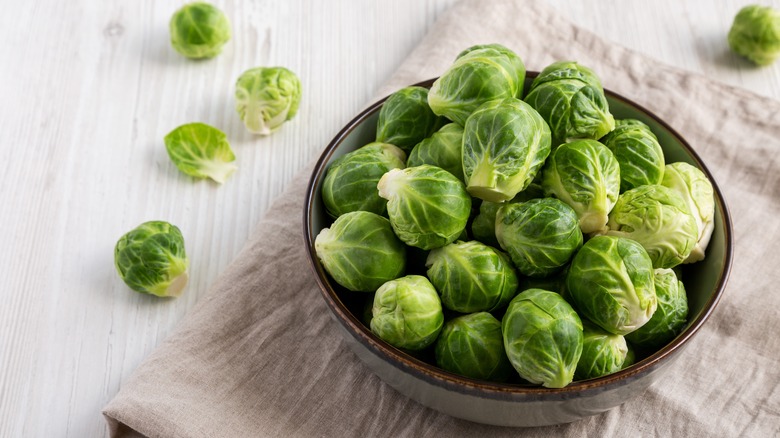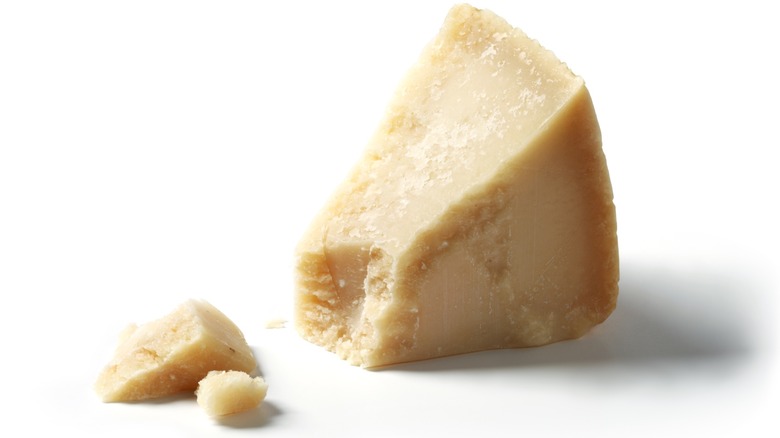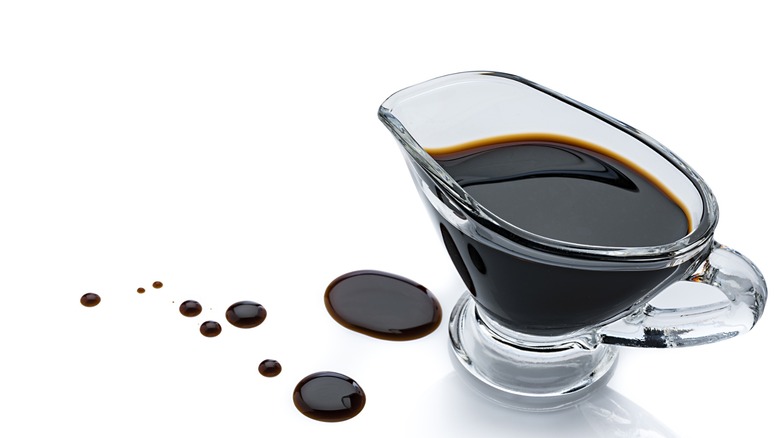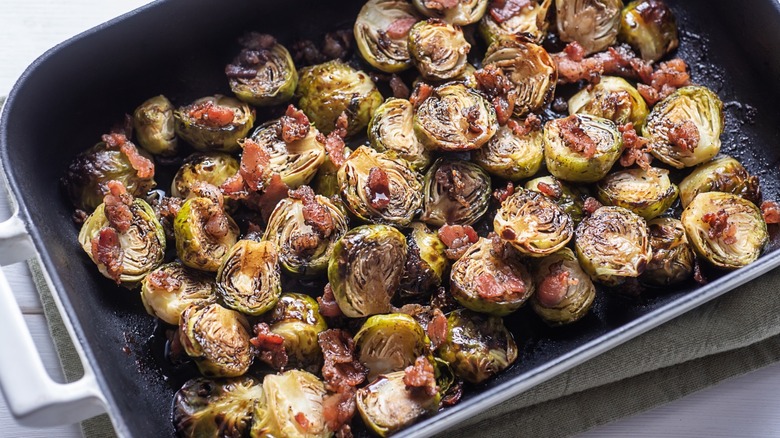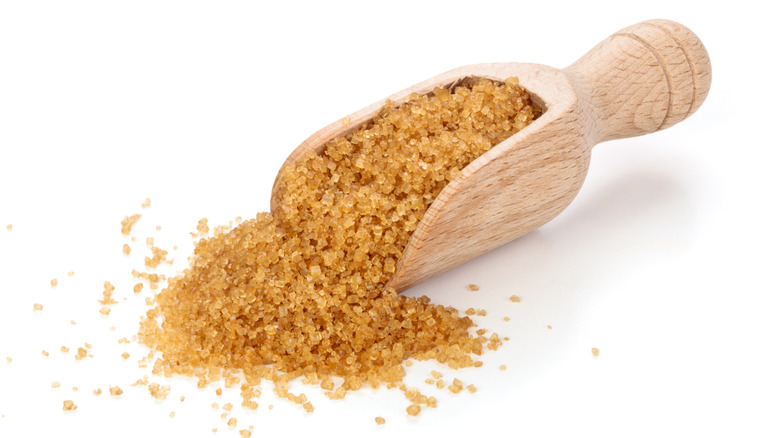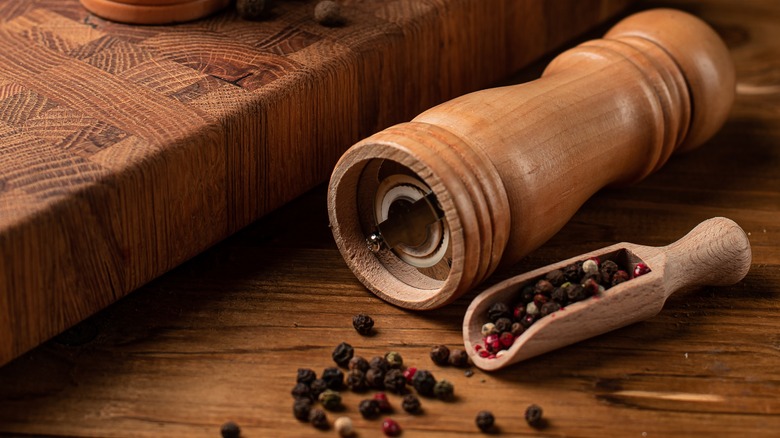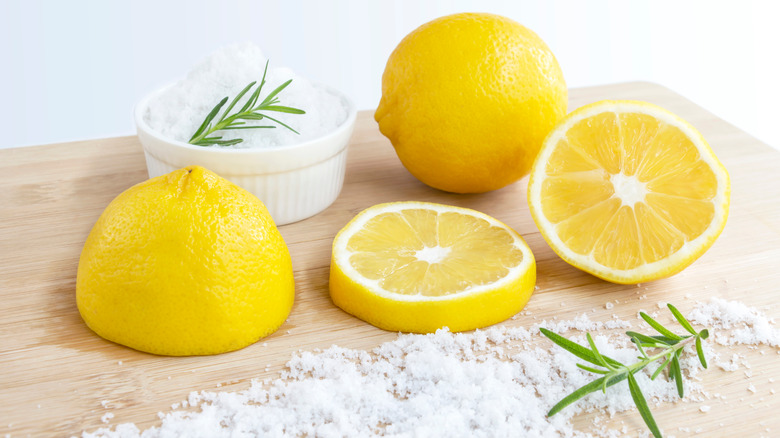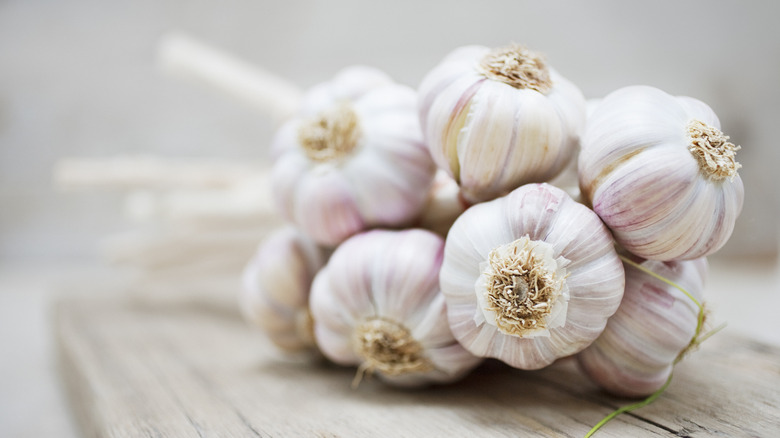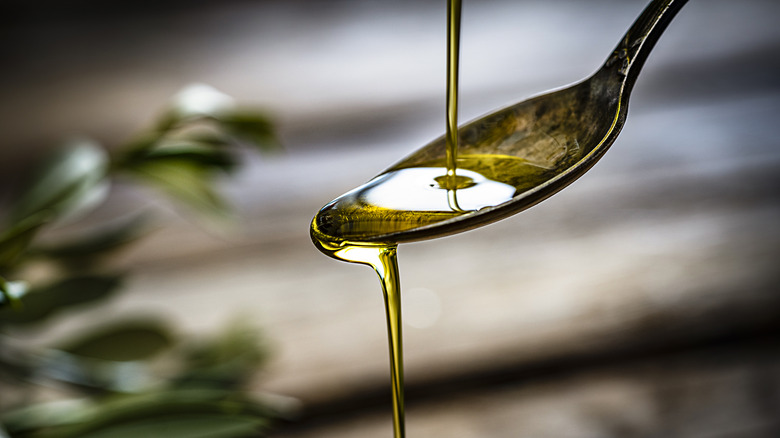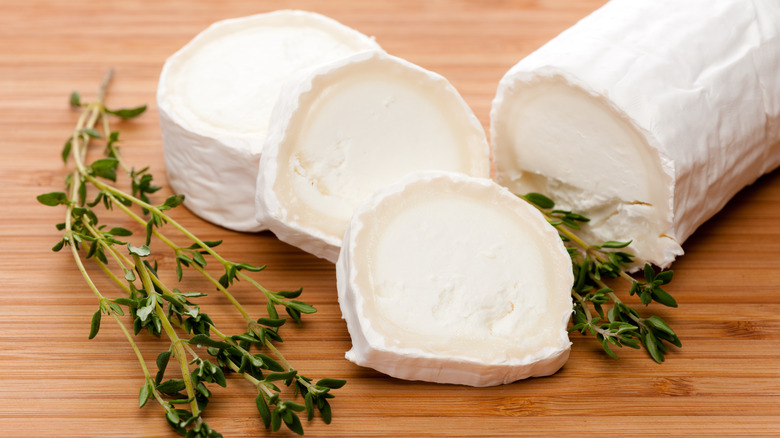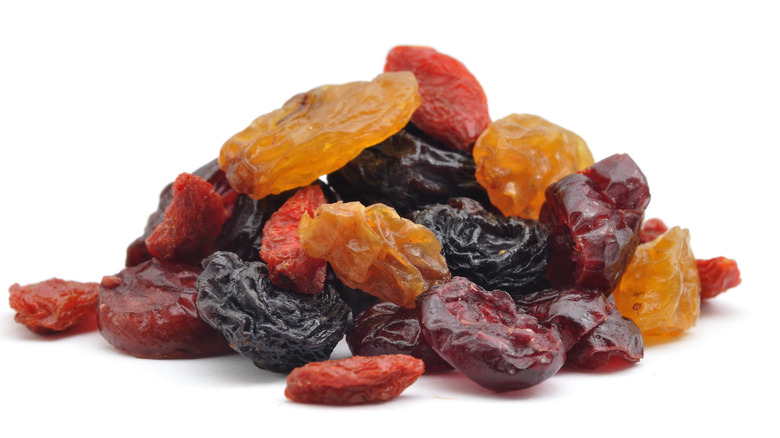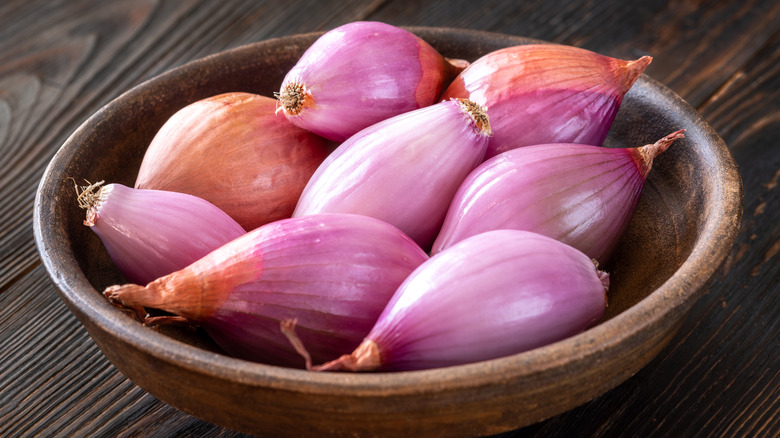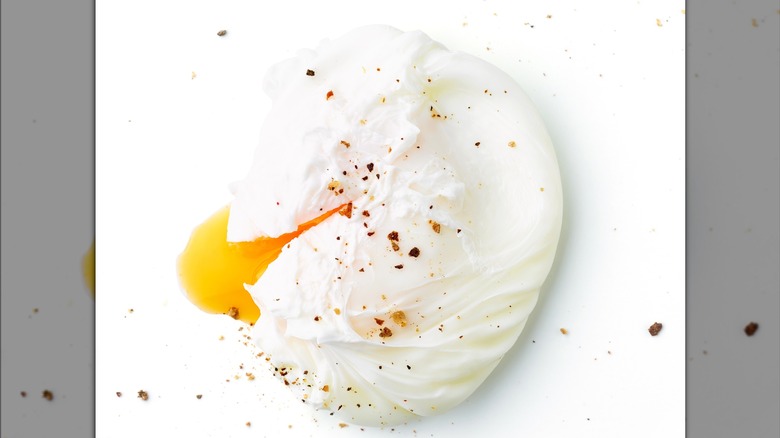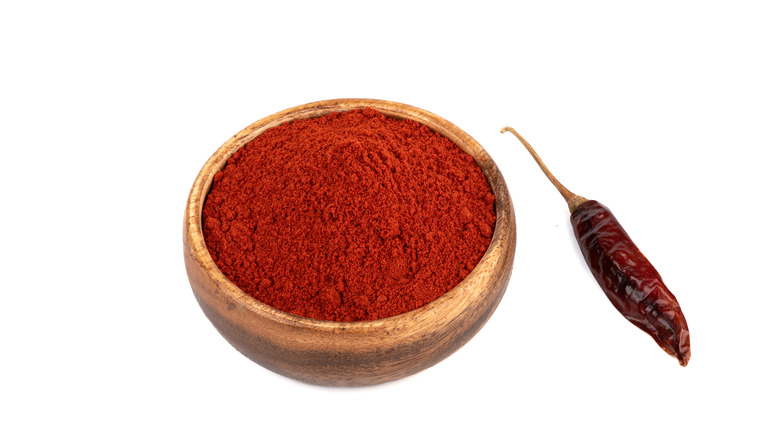14 Delicious Ingredients That Will Boost The Flavor Of Brussels Sprouts
Does anyone ever list Brussels sprouts as one of their favorite foods? These cabbage-family vegetables have long held a reputation for being stinky and bitter taste. But they can actually be a delicious addition to any meal when prepared well.
First cultivated between the 17th and 18th centuries in Belgium, Brussels sprouts got their name from the country's capital city. Despite their inherent bitterness, they've been eaten for centuries, long before their nutritional value was fully known. Like many small-but-mighty foods, sprouts are packed with things like vitamins C and K and might even play a role in preventing some cancers.
Thankfully it's easier to access those nutrients today because these sprouts have been bred to be less bitter. Dutch scientists have ensured that whether you roast, sauté, or fry them, you're more likely to discover the earthy, slightly nutty, and sweet side of sprouts. And then you can boost that flavor with an additional ingredient or two—things you likely already consider delicious such as cheese or bacon.
1. Toss your sprouts with Parmesan cheese and butter
So you've cleaned and prepped your Brussels sprouts and given them a good roast in the oven. Now what? If you're in the mood for something nutty — perhaps to complement the fresh acidity of your main dish — you can add two ingredients to highlight that aspect of the sprouts' natural flavor: Parmesan cheese and butter.
The cheese has its own nutty flavor thanks to the aging process it goes through. For more nuttiness, make sure to choose a Parmigiano-Reggiano cheese as it has been aged longer giving more time for the flavor to develop. Keep in mind that adding Parmesan will also add salt to your sprouts, so you may want to salt lightly when prepping the sprouts before roasting. Then taste as you go to get the balance of saltiness just right.
To make sure that delicious Parmesan sticks to the sprouts, toss them in melted butter first. This will add another layer to that nutty flavor you're building too. For extra credit (and extra nuttiness) use browned butter.
2. Drizzle roasted sprouts with balsamic vinegar
Roasting vegetables to a caramelized (dark golden brown) state brings out their sweetness. This even works on potentially bitter veggies like Brussels sprouts. The key is high heat and leaving them alone to do their thing. But don't wander too far from the oven because "caramelized" can very quickly become "burnt" which is not what you're going for.
When your sprouts have finished roasting, you can up the sweetness by drizzling balsamic vinegar over them. Made from grapes, the vinegar brings a sour sweetness to the party that works well with the earthier sweetness of the sprouts. Best of all, balsamic vinegar's tartness will help to balance everything and keep it from getting too sweet.
Pro tip: Let your guests control their own ratio of balsamic vinegar to Brussels sprouts. Drizzle a small amount of vinegar before presenting the dish and then provide more for people to add based on their taste.
3. Bacon makes everything better
Who would argue with adding one ingredient that brings salt, fat, and smokiness all at once? Probably not people eating Brussels sprouts. In fact, bacon and Brussels sprouts might be one of the best food pairings ever created. Together they cover sweet, salty, bitter, and umami — four of the five basic human taste profiles.
If you have time and patience, you can wrap each individual sprout in bacon to create little salty, smoky, sweet packets of flavor. As the savory bacon flavor mingles with the just-right bitterness of the sprout, you just might find it hard to believe that no one lists Brussels sprouts among their favorite foods.
Need an easier version of adding bacon to your sprouts? Just chop up uncooked bacon and sprinkle it over the sprouts before putting them into the oven to roast. Because the bacon will essentially baste the sprouts with both fat and salt as everything cooks, you don't need to oil or season them ahead of time.
4. Glaze your Brussels sprouts with brown sugar
While roasting is the best way to bring out the natural sweetness in vegetables, you may not always have the time needed to get them just right. In those moments you can opt to steam your sprouts instead. Just 8 to 10 minutes in a steamer basket is all they need to soften up. For the sweetness you'd get from the roasting process, create a simple brown sugar glaze.
As the sprouts steam, melt some butter in a sauté pan. Stir a few tablespoons of brown sugar into the melted butter and let them combine. You can adjust the amount of sugar depending on the bitterness of the sprouts and your preferred level of sweetness. Add the steamed sprouts to the glaze and stir to make sure they're evenly coated.
Experiment with using both light brown and dark brown sugar for glazing your sprouts — or simply use your favorite! Dark brown sugar has a higher amount of molasses added to it which yields a deeper caramel flavor. If you're looking to replace the natural caramelization that comes from roasting Brussels sprouts, using the darker sugar is the best choice.
5. Grab your pepper mill
There's no need to over-complicate things when it comes to Brussels sprouts — especially if you're already a fan of their flavor profile. If you prefer to keep your sprouts super simple and let their inherent flavors shine, then you can opt for adding a slight kick of spice by grinding fresh black pepper over raw or cooked sprouts just before serving. Because pepper flavor mellows with cooking, the last-minute grind allows its full strength to complement the earthy, nutty notes of the Brussels sprouts.
For a milder heat, use pink peppercorns instead of black. Did you know pink peppercorns are related to mangoes? This botanical relationship means those peppercorns also bring a fruity sweetness to your sprouts. The contrast between the fruitiness of the pepper and the earthiness of the sprouts may be just what your dish needs to take it from good to great.
Whichever pepper you decide to use, be sure to flavor "to taste" so you strike the right balance. This means adding a little bit of pepper at first, tasting the dish, and then adding more a little bit at a time until everything is just right.
6. Dress fried sprout leaves with lemon juice and salt
Maybe you don't want to eat the whole Brussels sprout. Maybe you're looking for a light appetizer to serve before a heavy meal. Follow chef Shannon Troncoso's lead and just fry the leaves. This does require taking the time needed to remove each leaf from the sprout, so plan your day accordingly.
Once the leaves are ready to go, fry them in oil. Troncoso's restaurant utilizes the deep fryer, but you can replicate that at home with oil and a skillet with high sides. The leaves don't take long to brown. Once they do, remove them from the oil and drain them so they aren't greasy.
The final step of Troncoso's dish is to toss the fried sprout leaves with lemon juice and salt. Acid from the citrus juice will cut through the fat from the oil to keep everything light and fresh. The salt — added to taste, of course — enhances the flavor combination of the earthy sprout leaves and the sour lemon juice.
7. Sauté those Brussels sprouts with garlic
Garlic adds a savory note to any dish. As it cooks, the flavor of garlic mellows from spicy to nutty which can be a tasty addition to the nutty flavor found in Brussels sprouts. When it comes to cooking with garlic, use a little or a lot according to your taste. And mincing fresh cloves is always better than sprinkling garlic powder over those beautiful sprouts.
For this particular sprout flavor enhancement, it's important to remember that garlic can go from "cooked and flavorful" to "burnt and unpleasant" rather quickly. On the other hand, Brussels sprouts need around 10 minutes to reach al dente. Keeping all of that in mind, start by sautéing the sprouts (in oil or butter) for 5 minutes — or until they're about halfway to done — and then add the garlic. Stirring or tossing the contents of the pan regularly will also help to avoid burning.
Pro tip: Adding garlic to any of the sweet items suggested in this list can help maintain the balance of sweet and savory as needed. On the flip side, you can always add something sweet to this dish to get the balance you're looking for.
8. Use your favorite oil
Did you know oils have different flavors? It's why you typically don't use olive oil when baking sweet treats. This is something to keep in mind as you prep your sprouts to roast them. Because roasting will bring out the sprouts' inherent sweetness, you can choose an oil that will work with that flavor instead of against it.
If you want something neutral to keep the sprout flavor as the star, you can use avocado oil. For a fruity note to balance the earthy sprouts, choose olive oil. And for additional nuttiness, opt for sesame oil.
Oil can also be used as a simple dressing rather than part of the pre-roast prep. Simply choose the flavor profile you want and toss the sprouts in the corresponding oil once they're done cooking. Remember that a little goes a long way, so add your chosen oil gradually and keep tasting till you reach "just right."
9. Add tartness with goat cheese
Most of the ingredients mentioned so far have been foods with similar flavor profiles to the ones found in Brussels sprouts. Adding them helps to create layered nuance within the earthy, nutty, and sweet flavors of the sprouts. Now it's time for some contrast — brought to you by the intense tartness of goat cheese. That tangy brightness of the cheese gives your taste buds a break from the nutty earthiness of the sprouts. It's a little bit of something new and interesting to keep you going back for more.
In addition to the new flavor profile, goat cheese provides a creamy textural contrast to the crunch of the sprouts. Crumble goat cheese over warm sprouts and let the residual heat go to work. The result will be little pockets of tangy, creamy goodness among the nutty, crunchy sprouts.
As an added bonus, goat cheese has a lower level of lactose than cheeses made with cow's milk. This makes it a potential alternative for lactose-intolerant folks who still want to experience cheesy sprouts.
10. Mix in your favorite dried fruit
To continue with the idea of contrasting flavors and textures, consider your favorite dried fruits: cranberries, cherries, raisins, apricots, and figs. Regardless of what you choose, you'll get a textural difference from the chewiness of the fruit. Whether your sprouts are roasted and soft or fried and crispy, they'll have a different mouth feel than whatever fruit you add.
For full contrast, choose dried cranberries or cherries. Like goat cheese, they provide a bright tartness that feels opposite to the Brussels sprouts but still makes an excellent partner. For a sweetness that complements the sprouts while keeping the textural contrast, choose raisins, dried apricots, or figs. Experiment with different kinds of dried fruit to find your favorite sprout-fruit combination. You can even combine fruits for additional layers of flavor. Dried fruit makes an excellent addition to raw sprouts as well as cooked. Enhance your next shaved Brussels sprouts salad with your fruit of choice.
11. Roast or sauté the sprouts with shallot
Much like garlic, shallots can bring both savory and sweet layers of flavor to your Brussels sprouts in a way that complements the nuttiness of the sprouts. And because cooked shallots have a more subtle flavor than onions, they won't overpower the natural flavors of the sprouts either.
The easiest way to add this ingredient is by tossing sliced shallots on the tray with the sprouts as they roast so their flavors mingle. For sautéed sprouts and shallots, let the shallot start in the oil for a few minutes before adding the sprouts. This way the oil starts to take on the shallot flavor and can carry it into the sprouts as they cook.
For a different way to combine sprouts and shallot: Roast the sprouts and fry the shallot separately. Frying sliced shallot in oil creates a crispy, sweet topping for the sprouts. As an added bonus, you can toss dry-roasted sprouts in the shallot oil to make sure that flavor infuses the whole dish.
12. Top your Brussels sprouts with a fried or poached egg
Have you had the experience of piercing the yolk of a perfectly cooked sunny-side-up or poached egg and letting it coat the food below? The yellow-orange yolk mingles with the other colors of the dish to create a momentary work of art. Not only does it look pretty, but that yolk has a creamy richness to it that elevates whatever you're eating. And that makes a fried or poached egg a perfect addition to this list.
The egg yolk itself doesn't bring much to the table in terms of flavor. So when you add a sunny-side-up or poached egg to your sprouts, the yolk adds creaminess while letting the sprout flavor shine through. For the sprout part of the dish, you could go with shredding them and leaving them raw or cook them any way you want: shredded and sautéed in a hash, halved and steamed, or halved and roasted.
13. Let smoked paprika substitute for bacon
Bacon might make everything better, but not everyone eats it. What if you need a vegetarian Brussels sprout dish but you still want it to have the smokiness of bacon? Fortunately smoked paprika exists. Made by smoke-drying chili peppers, smoked paprika brings chile flavor without the heat. Much like bacon, adding it to Brussels sprouts creates a depth of flavor that encompasses a number of human taste profiles. The result is a satisfying dish even without the meat.
To get the best version of this flavor enhancement, utilize some of the other information provided throughout this list. While you dry roast the sprouts, mix smoked paprika with a neutral-flavored oil such as avocado oil. Let the mixture sit so the flavors can mingle. Toss the roasted sprouts in the oil-paprika mixture and let them sit for a few minutes to absorb the flavorful goodness. Add salt to taste.
